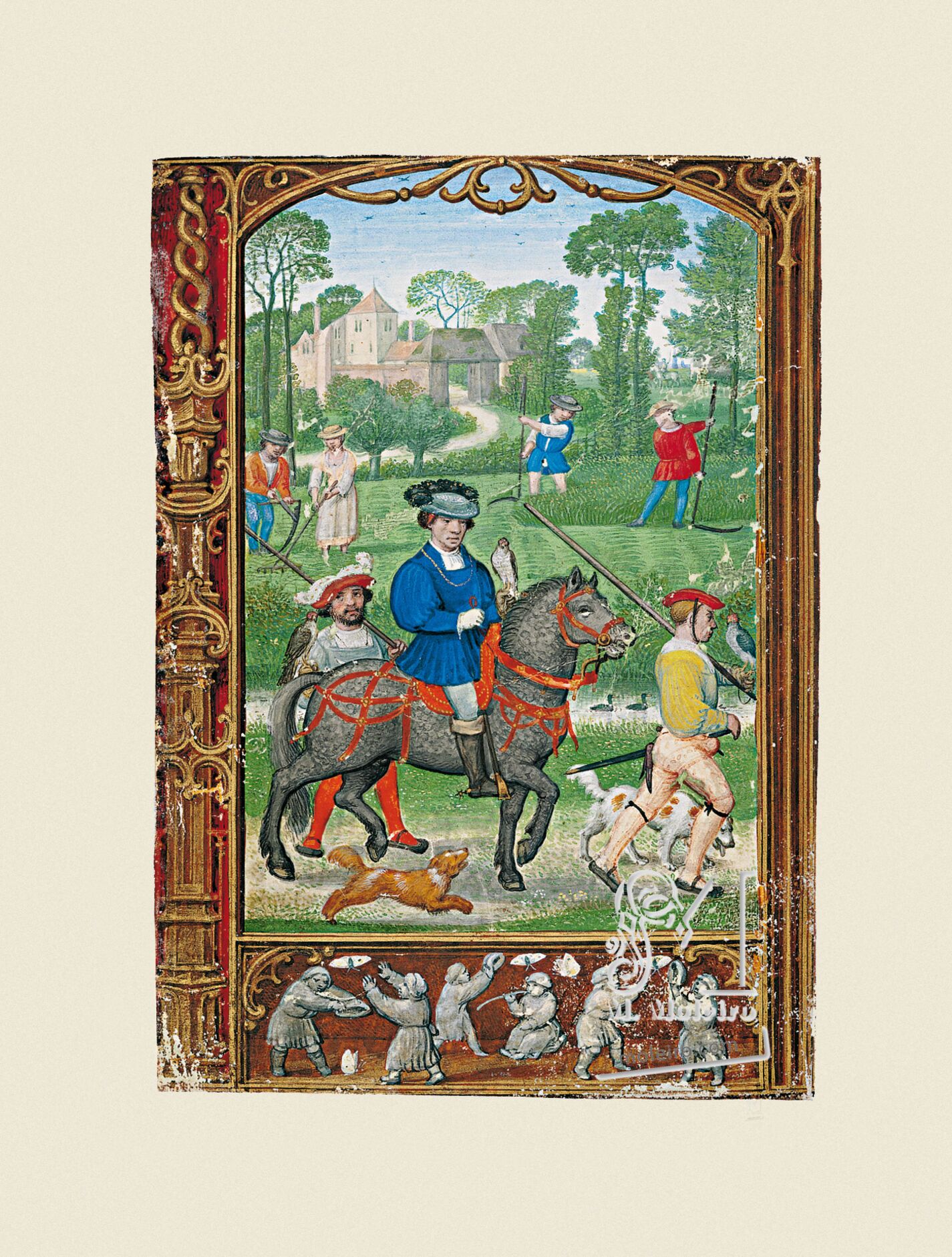The main image on f. 24v shows a nobleman on horseback in the foreground practising falconry. The man is wearing a blue tunic with a square neckline and a high-necked, buttoned shirt underneath. He wears a feathered hat, a glove on his right hand, full-length hose and ankle boots. A gold chain hangs round his neck and a falcon, possibly a peregrine falcon, is perched on the gauntlet on his left hand. Horses were not merely mounts but signs of nobility and an indication of social, moral and financial standing, i.e. status symbols. The nobleman is accompanied by servants carrying falcon’s perches (tall staffs covered in soft fabric for birds to rest upon and for beating bushes and trees to make prey take flight) and also a hooded peregrine falcon and goshawk. The leather thong or strap attached to the jesses to tie the bird to the falconer’s hand can also be seen. The servants are dressed in doublets – the one on the far right with a jerkin on top – with a high-necked, closed shirt and thigh hose and stockings held in place by garters They wear caps, one trimmed with white feathers, and are followed by two dogs which retrieve the prey brought down by the falcon.
The falconry motif is of oriental origin: no models have been found in classical art although it already existed in the Chinese art of the Tang dynasty. The hunting topic depicted most often in Latin West calendars was falconry. This sport, which was introduced in the early centuries of Christianity, originated in the Middle East and gradually became the favourite pastime of the aristocracy. One of the first pictorial records of this subject stems from one of the mosaic floor panels in the Falconer’s Villa in Argos featuring several falconry scenes. It appeared late in the Middle Ages: the first representation in a calendar – albeit in the month of May – is to be found in those in the Winchester Psalter and the St Albans Psalter, both made in the 12th century, in the third and fourth decades respectively. The model used in the Golf Book is not French but English, and depicts the rider standing next to his horse with the falcon upon his hand, with falconry images being more commonplace in the 14th century. They can be seen in Ambroggio Lorenzetti’s Allegory of Good Government and in the month of September in a calendar cycle in the Torre Aquila fresco in Trento castle. What is apparently certain is that this motif stems from sources unrelated to traditional calendar sources, such as medical treatises, hunting treatises and even romans. Falconry was one of the nobility’s favourite pastimes. Being an indication of power and wealth, it encouraged socialising and sophisticated games whilst revealing the elegance and courtesy of lords and formed part of aristocratic life.
Carlos Miranda García-Tejedor
Doctor in History

The main image on f. 24v shows a nobleman on horseback in the foreground practising falconry. The man is wearing a blue tunic with a square neckline and a high-necked, buttoned shirt underneath. He wears a feathered hat, a glove on his right hand, full-length hose and ankle boots. A gold chain hangs round his neck and a falcon, possibly a peregrine falcon, is perched on the gauntlet on his left hand. Horses were not merely mounts but signs of nobility and an indication of social, moral and financial standing, i.e. status symbols. The nobleman is accompanied by servants carrying falcon’s perches (tall staffs covered in soft fabric for birds to rest upon and for beating bushes and trees to make prey take flight) and also a hooded peregrine falcon and goshawk. The leather thong or strap attached to the jesses to tie the bird to the falconer’s hand can also be seen. The servants are dressed in doublets – the one on the far right with a jerkin on top – with a high-necked, closed shirt and thigh hose and stockings held in place by garters They wear caps, one trimmed with white feathers, and are followed by two dogs which retrieve the prey brought down by the falcon.
The falconry motif is of oriental origin: no models have been found in classical art although it already existed in the Chinese art of the Tang dynasty. The hunting topic depicted most often in Latin West calendars was falconry. This sport, which was introduced in the early centuries of Christianity, originated in the Middle East and gradually became the favourite pastime of the aristocracy. One of the first pictorial records of this subject stems from one of the mosaic floor panels in the Falconer’s Villa in Argos featuring several falconry scenes. It appeared late in the Middle Ages: the first representation in a calendar – albeit in the month of May – is to be found in those in the Winchester Psalter and the St Albans Psalter, both made in the 12th century, in the third and fourth decades respectively. The model used in the Golf Book is not French but English, and depicts the rider standing next to his horse with the falcon upon his hand, with falconry images being more commonplace in the 14th century. They can be seen in Ambroggio Lorenzetti’s Allegory of Good Government and in the month of September in a calendar cycle in the Torre Aquila fresco in Trento castle. What is apparently certain is that this motif stems from sources unrelated to traditional calendar sources, such as medical treatises, hunting treatises and even romans. Falconry was one of the nobility’s favourite pastimes. Being an indication of power and wealth, it encouraged socialising and sophisticated games whilst revealing the elegance and courtesy of lords and formed part of aristocratic life.
Carlos Miranda García-Tejedor
Doctor in History